|
|
|
|
 Danger Den TDX Waterblock review Danger Den TDX Waterblock review
|
|
Date Posted: May 14 2004
|
|
Author: pHaestus
|
|
|
|
|
Posting Type: Review
|
|
Category: H2O and High End Cooling Reviews
|
|
Page: 1 of 1
|
|
Article Rank:No Rank Yet
Must Log In to Rank This Article
|
|
|
|
|
Note: This is a legacy article, imported from old code. Due to this some items on the page may not function as expected. Links, Colors, and some images may not be set correctly.
|
|
|
Danger Den TDX Waterblock review By: pHaestus
|
|
|
Danger Den TDX Waterblock Review
By: pHaestus 5/14/04
|
|
|
The Danger Den TDX is the latest CPU waterblock design from Danger Den. The TDX has a copper baseplate, two chrome HF (high flow) barbs,
and a lexan (brass available) top. As with the RBX (their previous waterblock), several different nozzles are available to tune the TDX's inlet restriction to match your cooling loop. Mounting is done
with bolts and springs through motherboard mounting holes and the TDX top plate, and top plates are available to use the TDX with AMD's Socket 462 (Socket A), all Athlon64 sockets, and Intel Socket 478 (Pentium 4)
and Socket 603/604 (Xeon) motherboards.
Here's what Dangerden said about the TDX design concept:
"Based off the popular RBX waterblock design, the TDX takes advantage of all the features and performance levels that made the RBX one of the
best performing waterblocks on the market, while simplifying and improving the user interface. Key features of the TDX include:
|
|
|
|
- Incorporates the use of two HF fittings vs. three on the RBX, while maintaining the high level of performance achieved with the RBX.
- With the elimination of the third fitting there is no longer a need for the "Y" adapter to plumb the TDX in your system.
- Reduces the amount of hose clamps and tubing required to plumb the TDX into your system"
Jeremy Burnett of Danger Den
When I first inspected at the TDX, I was immediately impressed with the changes that had been made from the RBX design and with the machining quality and
construction. I am not a huge fan of three-barb waterblocks (too much hassle to route tubing without putting torque on block), and a return to the traditional two-barb design is welcome. I found the base of the RBX
to be a bit narrow for mounting reproducibly well in previous testing, and the TDX has addressed this by widening the base.
|
|
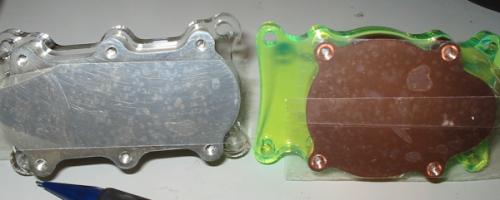 |
|
|
|
It now squarely hits all the pads on my AMD 1700+, which is a good thing. This is also good for A64 and P4/Xeon users, because the RBX didn't cover an
integrated heat spreader completely.
|
|
|
|
|
|
|
|
|
|
|
|
I believe the TDX should; it's narrowest width in the center part of block is 40mm (as opposed to 30mm for the RBX). The new "HF 9/32"" barbs Danger Den
is using for the TDX (first seen on the DTek White Water blocks) are another nice new change. They are lower profile, have o rings between the threads and the base of the barb, and have a noticeably larger inside diameter
than normal 1/2" hose barbs.
The combination of these barbs and a single outlet means that the flow resistance of the TDX should definitely be less than the RBX. The low profile design of the barbs is also a positive change because it means that hose clamps won't come in contact with wingnuts or thumbscrews when you are tightening the block down.
|
|
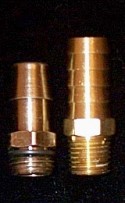 |
|
|
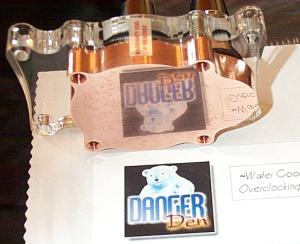 |
|
|
|
The baseplate finish is such an improvement over previous Danger Den products I have tested that I felt it deserves special mention. The TDX baseplate
finish was excellent; much better than the Maze4 or RBX that I have tested. I have asked Bruce at Cooltechnica to comment on the finish of all retail blocks when he receives his shipment and will update this review at that time. The rest of the machining is also top notch. Instead of sandblasting the TDX (as with Maze 3,4, and RBX), Danger Den deburred the TDX for a shiny finish throughout. They certainly have good machinists producing these blocks.
|
|
|
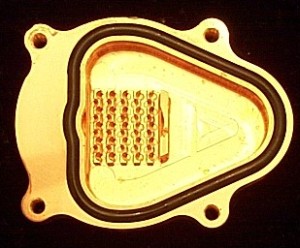 |
|
|
The internal design of the TDX is basically a tweak of the RBX: The same channel design is present but it is rotated 90 degrees so that the outlets from the
channel can be merged into a single outlet at the top of the block. The similarity in design between the RBX and TDX extends to the interchangeable nozzles; it is possible to customize the width of the nozzle inlet
piece to match the other components in your cooling loop. If you have multiple waterblocks and a weak pump then you may wish for a wider nozzle; those cooling only CPU with a powerful pump may choose a more restrictive
inlet to increase water velocity over the CPU die.
|
|
|
|
|
|
Test Results and Observations
|
|
|
|
|
|
|
|
|
|
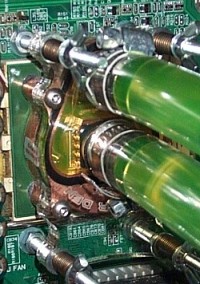 Testing methods are the same as used in earlier waterblock reviews. One new development is the estimation that my TBredB 1700+ at
13x175fsb and 1.85V (BIOS) generates approximately 73W under load. I am hesitant to convert the graphs from deltaT to C/W as of yet (still playing with this sort of W estimation), but that should give
you a ballpark number for CPU power. Rather than use the included springs from Danger Den, I used the same mounting hardware used in RBX, Whitewater, Cascade, Maze4, and #rotor block testing.
This ensures that all blocks are on a level playing field. Testing methods are the same as used in earlier waterblock reviews. One new development is the estimation that my TBredB 1700+ at
13x175fsb and 1.85V (BIOS) generates approximately 73W under load. I am hesitant to convert the graphs from deltaT to C/W as of yet (still playing with this sort of W estimation), but that should give
you a ballpark number for CPU power. Rather than use the included springs from Danger Den, I used the same mounting hardware used in RBX, Whitewater, Cascade, Maze4, and #rotor block testing.
This ensures that all blocks are on a level playing field.
A word of explanation about the following graphs may be helpful. I measure CPU diode temperature, the temperature of the water at the
waterblock's inlet, and the water flow rate. By plotting the difference between CPU temperature and water temperature, we can normalize all testing. This is required because water temperatures may vary
from day to day in my testing room. The closer that this delta T (engineering-speak for temperature differential) is to 0, the better the waterblock is performing.
The first test I conduct is the variation of waterblock performance over many mounting replicates at
1.50GPM flow rate:
|
|
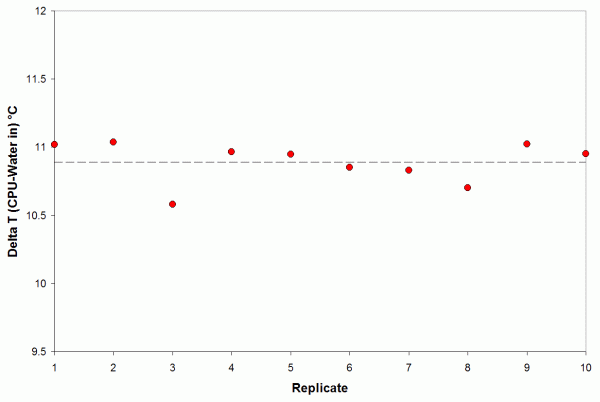 |
|
|
The average temperature difference between the CPU diode and the water temperature at the waterblock inlet was 10.89C (dashed line), and the standard
deviation over 10 mounts was 0.18C. You can see that the individual tests are pretty evenly scattered around the average. This standard deviation is MUCH better than my previous tests with the RBX and so I assume
that the wider base on the TDX does indeed improve mounting reproducibility.
The next test I conducted is the relationship between waterblock performance and flow rate. Since most readers will be interested in how this
block compares to the RBX, I am plotting the RBX performance numbers on the same figure:
|
|
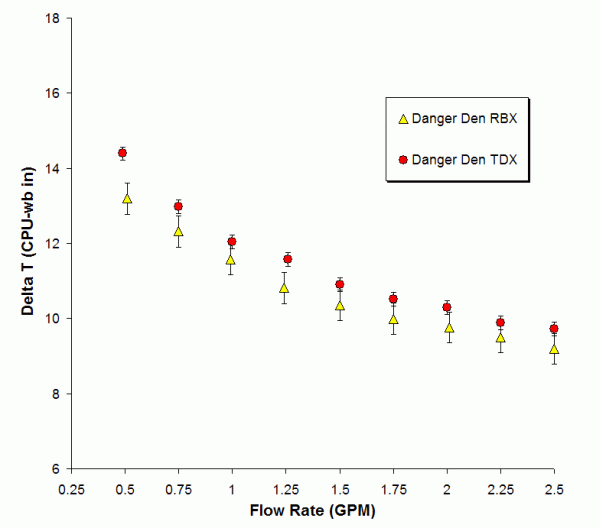 |
|
|
At very low flow rates (0.5GPM) the TDX performs about 0.7C worse than the RBX. This performance difference decreases to around 0.4C at high
flow rates (2.25 and 2.5 GPM). This is not really a fair comparison though.
The TDX waterblock is considerably less restrictive than the RBX. With my test system, the maximum flow rate through the RBX was 2.58GPM whereas 3.05GPM
was observed with the TDX. This means that that flow rates may possibly be 0.25GPM higher with the TDX than with an RBX in an otherwise identical cooling loop. If that were the case then end users would see
essentially identical performance from these two waterblocks.
This does present us with an interesting question: "What could be the cause of decreased performance with the TDX when data is normalized for flow?" Keep
in mind that I am testing with a TBredB CPU and that they are long and narrow cores. The long side of the core matches up with the long side of the channels for the RBX and the entire core is below channels/die area
impingement. For the TDX, though, the channels are flipped 90 degrees and so the ends of the channels are off the core and their cooling is essentially wasted. This effect is probably much more pronounced on the
TBredB I use for testing than it would be on a Barton or any other square core (where the channels would cover about the same amount of CPU in either orientation). It will be interesting to see if reviewers with other CPU
types report that the blocks perform closer together.
The TDX's performance is more easily compared with other waterblocks when they are all graphed on the same Delta T vs. Flow rate graph:
|
|
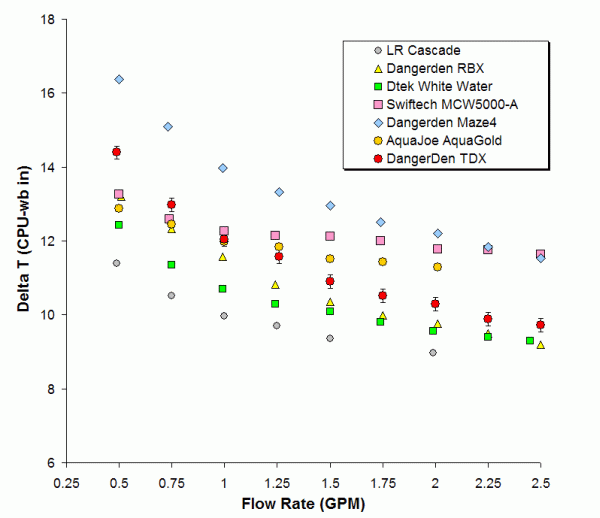 |
|
|
This graph is becoming less and less useful as I test waterblocks of widely differing design. The reader's instinct is to say the Maze4 is "a bad block"
or that the Cascade is "best", but the dT vs. Flow rate graph only tells one half of the story, though. In my test loop with fully open valves, I could push 3.05GPM through the TDX, 2.58 GPM through an RBX, 2.4GPM through
the WhiteWater, and only 2.15GPM through the cascade. This means that the TDX has a much smaller resistance to flow, and that an end user cooling only a CPU with a typical pump (Eheim 1250, Hydor L30) and a ½" loop could
expect flow much higher flow rates for the TDX than for a Cascade, Whitewater, or RBX. This typical user would see much less difference in performance than you'd expect by comparing all the blocks at an identical flow
rate. I freely admit that I need to produce head loss vs. flow rate graphs for the waterblocks I test; this information would allow us to make "apples to apples" comparisons. Ebay is being watched. One thing
that you can
tell from the graph is that the Danger Den blocks are not well suited to very low flow rate systems. I wouldn't suggest the TDX in a European-style loop with 3/8" OD tubing and an Eheim 1046, for example. With higher pressure pumps and a 1/2" loop, though, the TDX is a good choice. TDX performance should be similar to the RBX and WhiteWater in end user configurations (due to its reduced flow resistance) and the TDX will be easier to use.
In summary, I believe Danger Den has a winner with this block. I did not recommend the RBX due to mounting issues, but I have no reservations recommending
the TDX to those looking for a waterblock to use with a moderate-high power pump. If you are only cooling your CPU and have a high pressure pump (MCP600, Laing D4, or similar) then you should also consider using one of
the more restrictive nozzles. The TDX ships with a "general purpose" nozzle that can be replaced with more restrictive inserts for improved performance (at the expense of flow rate). I am testing out these inserts
as I type this and should have an in-depth review late next week on the topic.
Thanks to the guys at Danger Den for providing the Dangerden TDX for testing.
|
|
|
|
| Random Forum Pic |
 |
| From Thread: Modding Evolution of my beige box |
|
| | ProCooling Poll: |
| So why the hell not? |
|
I agree!
|
 67% 67%
|
|
What?
|
 17% 17%
|
|
Hell NO!
|
 0% 0%
|
|
Worst Poll Ever.
|
 17% 17%
|
Total Votes:18Please Login to Vote!
|
|






 Danger Den TDX Waterblock review
Danger Den TDX Waterblock review
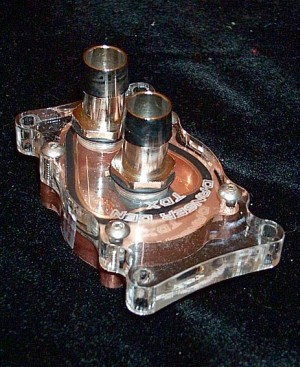




 Testing methods are the same as used in
Testing methods are the same as used in 

